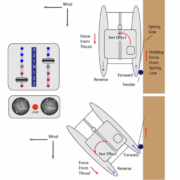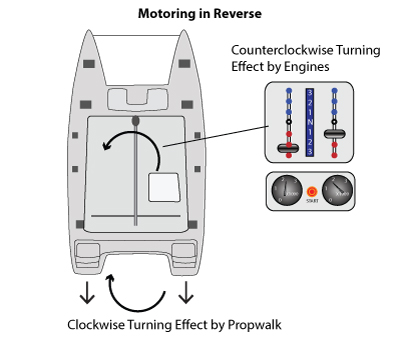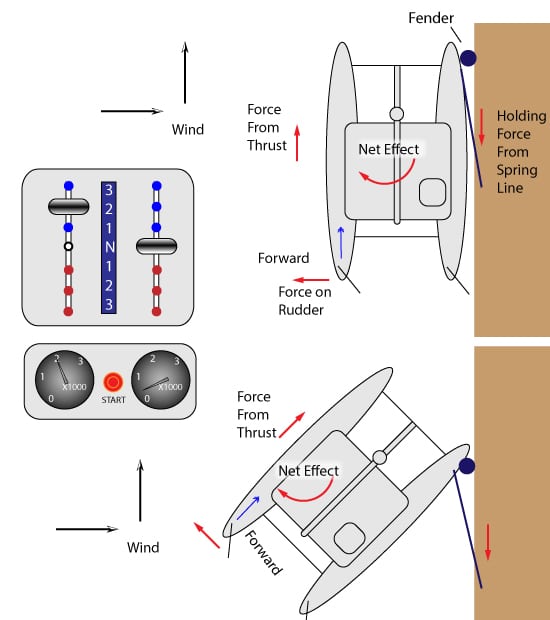Catamaran Maneuvering Mastery
As learned from the last pages in this course, catamarans can turn inside their own length, they can vector sideways, and using the bulldozer effect, you can instantly rotate the catamaran to point in any direction; you can do almost anything. They are the ultimate maneuvering machine. So next time you’re thinking about being intimidated by the beam and sheer size of the catamaran, think about how much more maneuverable the catamaran is. However, it takes practice and learned intuition to determine which throttles to use.
From the monohull exercises, you’re becoming a maneuvering master. So, now let’s look at some of the differences you’ll experience with a catamaran using the same monohull discussions on momentum, backing, propwalk, ferrying, and the use of spring lines.
Discovering the general maneuverability of the boat away from the dock and marina is important, not just for reducing embarrassment, but for your credit card deposit or insurance deductibles. Collisions in boats this expensive are simply unnecessary when you’ve spent a little time practicing and gaining an appreciation of the maneuverability of the boat. Essentially, you are learning the feel of the boat. Don’t be embarrassed—it’s much more embarrassing to even put a little scratch in the gelcoat in front of the charter office upon return. And besides, it’s fun to learn the maneuverability of the boat.
If you’re heading off chartering a catamaran for the first time, you’re probably a little disadvantaged by a lack of access to a catamaran. You’ve got a few choices based on your general monohull abilities. (1) Wing it – not prudent and probably disallowed by the charter company anyway. (2) Prearrange the charter company to give you a two to three-hour maneuvering confidence introduction when you first get the catamaran. (3) Get with a professional catamaran instructor and get your NauticEd professional Catamaran Endorsement. You do this by taking the NauticEd Catamaran Sailing Confidence Course online, combined with training and assessment by a NauticEd Catamaran Instructor/Assessor.
Regarding option (2), The NauticEd team has a lot of experience with this option. As yacht charter agents, yacht charter companies are happy to rent you a catamaran for the first time as long as you have heaps (and heaps) of big monohull experience AND you are open to a short maneuvering check-out/training session with one of their on-site captains. See this excellent blog article on this topic – Can I charter a catamaran with only monohull experience? Feel free to consult with our Sailing Vacation Team about your ability to charter a cat on a sailing vacation with limited Cat experience. Many times, however, we will suggest that you attend a NauticEd Catamaran training school to gain a Catamaran Endorsement on your sailing resume. This endorsement takes about 4-6 hours – assuming you are plenty experienced with monohull sailing and maneuvering.
Prop Walk
Prop walk problems in a catamaran? Nope! In a monohull, the boat will pull to port when engaging in reverse, and there is really not too much that you can do about it. (See this article on What Is Prop Walk). In a catamaran, the same will happen except, cleverly, we’ll engage the port engine in reverse a little more than the starboard engine. This creates a counterclockwise turning force that overcomes the port sideways stern movement created by prop walk.
If you’re having trouble visualizing this, remember that when motoring in reverse, propwalk will move the stern to port (creating a clockwise turning effect on the boat). To counteract this reversing turning effect, create an opposing counterclockwise turning effect by using slightly more reverse port engine than starboard engine. Once become really good at this through practice and building muscle memory, you won’t notice it because you automatically adjust the throttle positions to get the boat moving straight backward.
In reality, what will happen is that you’ll automatically compensate by using the bulldozer effect to point your boat in exactly the direction you need. Piece of cake (after practice).
Ferrying
A catamaran can ferry perpendicular to the wind or current in the same manner as a monohull, except it has far more capability to accurately angle itself perfectly to the wind and current flow. Refer to the ferrying example and animation earlier in Module 9.
Getting off the dock
Because the catamaran has the ability to spin on its own axis, rarely will you need to use spring lines to gain a turning moment. But there is also nothing preventing you from utilizing spring lines. They work the same as they do for a monohull.
In the situation below, you are tied starboard side-to the dock with a boat in front of you and another one behind you. The trick is going to be to pivot your Catamaran to either move the bow clear of the catamaran in front or the stern clear of the Catamaran behind you.
The best maneuver depends on the winds and currents, of course. This is going to be easier than a monohull because of the improved maneuverability of the Catamaran. If the wind is coming from ahead or blowing you off, clear the bow first with or without a spring line, whichever you are comfortable with, depending on the wind strength.
Here is the same maneuver with a spring line. Note the reduced use of the dockside engine.
To start:
- Make your plan.
- Inform the crew of the procedure and assign tasks.
- Check for obstacles in the water.
- Ensure the dinghy is clear. Ensure no lines are in the water.
- Check for traffic.
In the animation below, the wind is blowing you either into the dock or from behind. Note that since we are using both engines (one in reverse), you can probably get away without using a spring line. Also note that at the end, the rudders are turned and both engines are engaged. This is a sign that this boat has a normal setup – a rudder behind the propeller.
Now, refer back to the previous page of this course to remind yourself of how some catamarans have the rudder forward of the propeller (many Lagoon catamarans have this). We call this “wonkie” – just because it is not what you would normally expect. Usually, the rudder is aft of the propeller so that you can get a prop wash effect over the rudder in forward gear. When wonkie, the prop wash over the rudder is only when in reverse. Yes, that is certainly “wonkie”.
If you have a wonkie setup, the catamaran above would not have made that turn on the rudders alone. The bulldozer effect would have been needed.
Play the animation that shows a catamaran using opposing thrust to turn itself off a dock (rudders aft of the rudder).
The big advantage here over a monohull is that the two opposing thrust forces from the engines are a long way apart. This creates a large turning moment.
Remember: on a Catamaran, you hardly need to touch the wheel for close-quarter maneuvering. As a matter of fact, if your boat is equipped with a wheel brake, we would suggest putting it on while maneuvering. The other reason why it is a good idea to do this is so that you prevent the rudders from getting swung hard by the prop wash.
The animation below shows the same situation, but for winds from ahead or blowing you off the dock. Here, you’re only using the outer engine in reverse, so rig a spring line from aft to forward on the dock. The main reason is that there is reduced maneuverability because there is no wash over the rudder, and we don’t have a counter opposing forward thrust. Thus, the spring line acts to prevent the boat from moving backward.
Alternatively, for wind blowing you off the dock, you could vector the boat sideways.
- Which way do you turn the wheel for a normal rudder/prop setup?
- Which way do you turn the wheel for a wonkie rudder/prop setup?
For normal, you want to turn the bow out with the bulldozer effect and at the same time turn the wheel to force the stern out. Thus reverse on port and forward on starboard and turn the wheel towards the dock.
For wonkie, same bulldozer effect but turn the wheel away from the dock.
 Paper Exercise – do now – M10-3
Paper Exercise – do now – M10-3
Draw the above on a piece of paper and convince yourself you know and understand it.
Once you have cleared the boats around you, you can then bring the throttles back to neutral. At that point, if you need to angle your boat out and away using the bulldozer effect. Once pointed correctly, engage both forward throttles as appropriate.
Leaving the Mediterranean Mooring
Sometimes, you will also need to use a spring line to spring a cat upwind in a Med Mooring situation. Use an amidship spring line or aft spring line and forward thrust on both engines. During the process, you adjust each engine’s throttle independently to keep the bow pointing straight out of the mooring.
Leaving the Slip
If you are parked stern to or bow in, you would then leave the dock in either straight forward or straight backward motion just as you would in a monohull. But you have the added advantage of using the engines to point the bow or stern to overcome the effect of side windage.
In a straight backward motion, you’re going to feel the effects of prop walk dragging the aft to port. Unlike a monohull, this is easily overcome by applying slightly less reverse throttle on the starboard engine. This creates an anticlockwise turning moment, which counteracts the prop walk – that for right-hand screws, which most Cats are.
Quick note: Somehow, because you have a cat, it is so tempting to run things over by allowing them to pass down between the hulls. This is particularly prevalent in tight marinas because there are mooring balls everywhere.
- Try not to do it. There are pendants semi-floating next to a mooring ball. And your boat can get blown sideways onto the floating object just at the wrong time (been there done that – resulting in a long story)
- If you have to do it, disengage your gearing to prevent the prop from catching the pendant as you pass.
Returning to the Dock
Using the exercises described in the maneuvering section of this book, you’ll simply be able to maneuver your Cat into position, spin it around using both engines, and back into or drive into position.
While the wind will want to push your boat sideways, you always have control of the boat with both engines.
Depending on the wind, however, you may need to spring on. You can use exactly the same methods as for a monohull described earlier.
Vectoring the last few feet to the dock can be achieved as learned with the correct combination of thrust and rudder and understanding if you have a normal or wonkie rudder/propeller set up. But as stated, the vectoring force can not overcome wind force. Use spring lines instead.
If there are higher wind and current situations, just remember that since the Cat can spin within its own diameter, you can always abort whatever you are attempting and have another go from a different angle. Going around for a second pass is far less embarrassing than swapping gelcoat with another boat.
Tying up
If you are side to the dock, you can tie the non-dockside hulls to the dock in this manner. This provides for plenty of spring stretch in the lines but holds the boat to the dock.
If you are docking your catamaran stern to the dock, you can cross in an “X” two dock lines on the stern of the boat. The point is to tie lines as long as possible to allow for a spring stretch in the lines but to hold the boat in position.








 Paper Exercise – do now – M10-3
Paper Exercise – do now – M10-3





